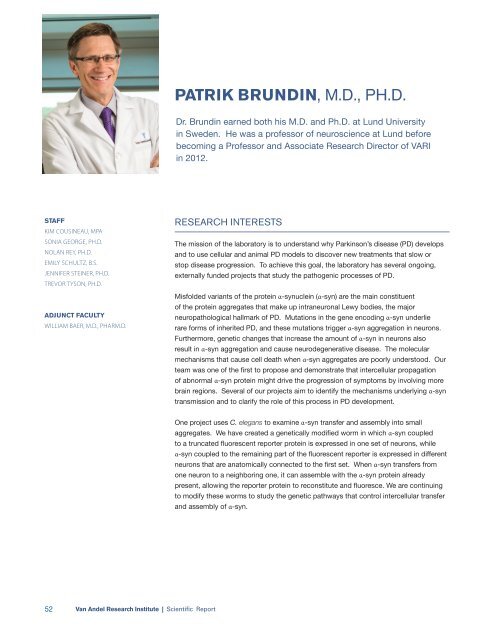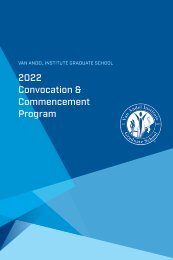2016 Scientific Report
You also want an ePaper? Increase the reach of your titles
YUMPU automatically turns print PDFs into web optimized ePapers that Google loves.
PATRIK BRUNDIN, M.D., PH.D.<br />
Dr. Brundin earned both his M.D. and Ph.D. at Lund University<br />
in Sweden. He was a professor of neuroscience at Lund before<br />
becoming a Professor and Associate Research Director of VARI<br />
in 2012.<br />
STAFF<br />
KIM COUSINEAU, MPA<br />
SONIA GEORGE, PH.D.<br />
NOLAN REY, PH.D.<br />
EMILY SCHULTZ, B.S.<br />
JENNIFER STEINER, PH.D.<br />
TREVOR TYSON, PH.D.<br />
ADJUNCT FACULTY<br />
WILLIAM BAER, M.D., PHARM.D.<br />
RESEARCH INTERESTS<br />
The mission of the laboratory is to understand why Parkinson’s disease (PD) develops<br />
and to use cellular and animal PD models to discover new treatments that slow or<br />
stop disease progression. To achieve this goal, the laboratory has several ongoing,<br />
externally funded projects that study the pathogenic processes of PD.<br />
Misfolded variants of the protein α-synuclein (α-syn) are the main constituent<br />
of the protein aggregates that make up intraneuronal Lewy bodies, the major<br />
neuropathological hallmark of PD. Mutations in the gene encoding α-syn underlie<br />
rare forms of inherited PD, and these mutations trigger α-syn aggregation in neurons.<br />
Furthermore, genetic changes that increase the amount of α-syn in neurons also<br />
result in α-syn aggregation and cause neurodegenerative disease. The molecular<br />
mechanisms that cause cell death when α-syn aggregates are poorly understood. Our<br />
team was one of the first to propose and demonstrate that intercellular propagation<br />
of abnormal α-syn protein might drive the progression of symptoms by involving more<br />
brain regions. Several of our projects aim to identify the mechanisms underlying α-syn<br />
transmission and to clarify the role of this process in PD development.<br />
One project uses C. elegans to examine α-syn transfer and assembly into small<br />
aggregates. We have created a genetically modified worm in which α-syn coupled<br />
to a truncated fluorescent reporter protein is expressed in one set of neurons, while<br />
α-syn coupled to the remaining part of the fluorescent reporter is expressed in different<br />
neurons that are anatomically connected to the first set. When α-syn transfers from<br />
one neuron to a neighboring one, it can assemble with the α-syn protein already<br />
present, allowing the reporter protein to reconstitute and fluoresce. We are continuing<br />
to modify these worms to study the genetic pathways that control intercellular transfer<br />
and assembly of α-syn.<br />
52 Van Andel Research Institute | <strong>Scientific</strong> <strong>Report</strong>

















